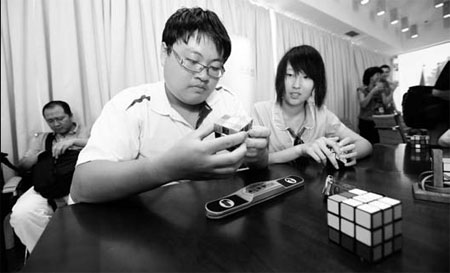Puzzling after all these years
 |
| Erno Rubik, a Hungarian interior architect, invented the cube, with the idea of using it to improve people's sense of space. |
 |
| Xu Yipin completes a Rubik's Cube at the Hungary Pavilion of the Shanghai Expo. |
The Rubik's Cube challenges a new generation of "speedcubers" three decades after its invention, Johannes Wagemann reports
It is brightly colored, angular and made of plastic. The Rubik's Cube has hardly changed in 30 years. But the three-dimensional mechanical puzzle remains as popular as it was when it first came on the mass market in 1980, particularly among those, both young and old, who like to test their ability to solve it quickly.
When someone holds a Rubik's Cube puzzle in their hands, he or she knows instinctively that it won't be easy to solve.
Six different colors are dispersed on squares on all sides of the cube. To solve it, the nine squares on each side must be turned so that, in the end, each side of the cube consists of only one solid color. It has been challenging people's patience ever since it began selling in large quantities in the early 1980s.
For some, it's too perplexing, but for others, it's so fascinating that they want to time how long it takes them to solve it in competition with other puzzlers. They call themselves "speedcubers" and they regularly hold contests to determine who is fastest at solving the puzzle.
The German speedcubing championship, for example, was held recently with Cornelius Dieckmann, a 15-year-old from Berlin, winning the German master award.
Robin Bloehm, 22, is another award-winning German speedcuber. He recalls the day three years ago when he was sitting in a math lecture not understanding a word when he noticed the guy next to him with a Rubik's Cube. His father had an old one and he tried it.
"At the beginning, it was something that required concentration and patience," he says. "But at some point it just came together automatically. Now it's about working the puzzle quickly."
The Hungarian interior architect who invented the cube, Erno Rubik, came up with the idea for the toy in the mid 1970s, with the idea of using it to improve people's sense of space.
At the time Hungary was part of the Soviet Union's Eastern Europe bloc, making marketing the toy difficult. It took until 1980 for it to be introduced to the mass market. Since then, 350 million Rubik's Cubes have been sold, according to Wikipedia.
It's best to understand a little bit about the construction of the cube before trying to solve it. The square in the middle of the nine squares on each side stays in place while the others around it move in all directions. There are several ways to solve the puzzle but the minimum number of turns is 22.
One way is the Fridrich method, in which different algorithms are used, meaning the cube's pieces have to be turned in a certain order. This is the method Bloehm employs to solve the puzzle. He got quick at it, but now as a student he doesn't have all day to practice, while younger speedcubers do.
Some speedcubers solve the puzzle as many as 1,000 times per day. No one has been able to beat the record of 7.08 seconds set two years ago by Erik Akkersdijk of the Netherlands.
"It's unbelievable how fast some of the younger players have become," says Reiner Thomsen. At age 45 he is among the oldest speedcubers.
"I had the cube in my hands when I was young," he said. His first contact with speedcubing came six years ago at a toy trade show in Essen. With practice the computer scientist got his time down to under 20 seconds.
Algorithms, mathematicians, computer scientists? Can only geeks solve the puzzle? Bloehm and Thomsen admit that the speedcubing scene is dominated by men and mathematicians.
"But they are all very informal," he says. "Naturally, we talk shop."
But it's still fun, even after 30 years, and especially in the era of video gaming consoles and computer games.
"My free time does not revolve around the cube. Far from it," says Bloehm. He worries that strenuous training could cause tendonitis in his hands and wrists. He advises speedcubers to use silicon spray so that the cube's sides turn more smoothly.
He adds that he leads a "normal life" and has a girlfriend. She has also come under the spell of the cube and is now among the fastest women at solving the puzzle.
 0
0 







Go to Forum >>0 Comments